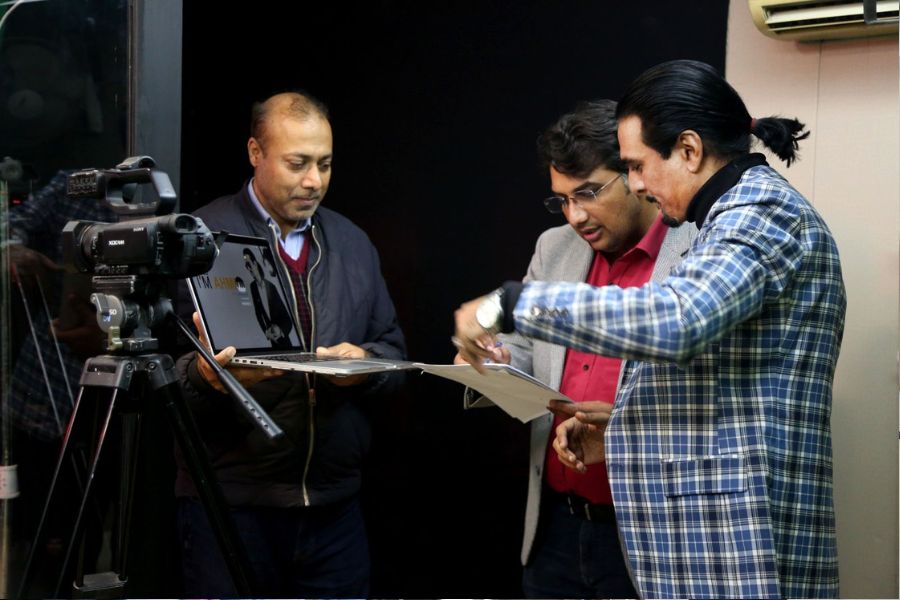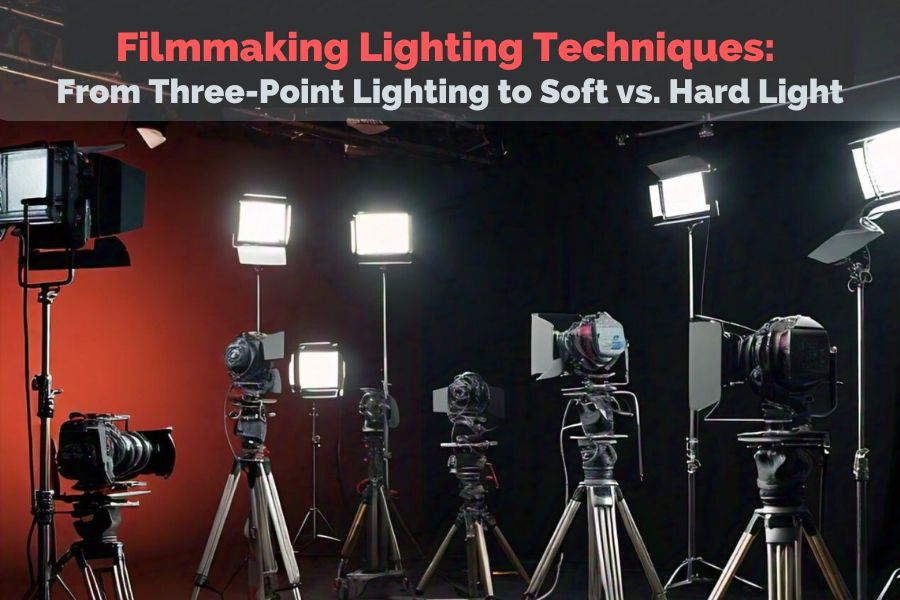Table of Contents
Introduction to Filmmaking Lighting Techniques
Welcome to the world of filmmaking lighting techniques, where every beam of light shapes our cinematic narratives. As Ahmad Afridi, I’m excited to delve into the intricacies of lighting that can transform your films from ordinary to extraordinary.
Lighting is not just about illuminating a scene; it’s about sculpting emotions, creating depth, and capturing the essence of storytelling visually. In this comprehensive guide, we will explore fundamental concepts like filmmaking lighting techniques, three-point lighting, cinematography basics, film lighting equipment, soft vs hard light, and how to master the art of lighting in your films.
Cinematography Basics: Three-Point Lighting

Key Light: Illuminating Your Vision
The key light acts as the primary source, defining the shadows and highlights on your subject’s face or object. It replicates the natural sunlight, providing the foundational brightness for your scene.
Examples of Key Lights in Action:
Portrait Photography: Imagine a portrait shoot where you want to emphasize the model’s features. The key light would be positioned strategically, often at an angle in front of the model, to illuminate their face and create natural-looking shadows that define their bone structure.
Cinematography: In movies, key lights play a crucial role in establishing the mood and tone. A high key lighting setup, where the key light is bright and fills most of the scene, creates a cheerful and optimistic atmosphere. Conversely, a low-key setup with a dimmer key light and more prominent shadows evokes a sense of mystery or suspense.
Product Photography: When photographing products for e-commerce websites or advertisements, a well-placed key light ensures the product is clearly visible and its details are showcased. The light placement can be adjusted depending on the product’s shape and texture.
Fill Light: Balancing Shadows and Highlights
By filling in the shadows cast by the key light, the fill light softens the overall look, ensuring a more natural and flattering appearance for your subjects.
Examples of Fill Light in Action
Studio Portraits: Professional photographers often utilize a three-point lighting setup, where the fill light plays a crucial role. Imagine a portrait scene: the key light illuminates the subject’s face, but creates a shadow on one side. The fill light, positioned on the opposite side, brightens that shadow, softening the overall look.
Natural Light Photography: Even with natural light, fill light can be improvised. A white reflector positioned opposite the sun can act as a natural fill light, bouncing sunlight back onto the subject and reducing unwanted shadows.
Product Photography: Product photography also benefits from fill light. It helps eliminate harsh shadows that can obscure product details and creates a more even, professional-looking image.
Backlight: Adding Depth and Dimension
Positioned behind the subject, the backlight separates them from the background, creating a sense of depth and adding visual interest to your shots.
Examples of Backlight in Action
Portrait Photography: Backlighting can be used to create a dramatic halo effect around a person’s hair, highlighting their features and separating them from a plain background.
Product Photography: Backlighting can be used to showcase the texture and details of a product, making it appear more visually appealing.
Nature Photography: Backlighting can be used to capture the beauty of fog, smoke, or dust particles floating in the air, adding an ethereal quality to the scene.
Essential Film Lighting Equipment
While professional studio lights are ideal, beginners can achieve impressive results with household lamps and affordable softboxes. Softboxes diffuse light, creating a gentle and pleasing illumination that suits various filming scenarios.
Household Lamps:
Standard table lamps or floor lamps can be used for basic lighting.
Experiment with positioning and diffusion materials (see below) to achieve softer light.
Softboxes:
Affordable diffusers that fit around household lamps.
They soften the light from the lamp, creating a more flattering look.
Understanding Soft vs Hard Light

Soft Light: Painting with Gentle Illumination
Soft light produces minimal shadows, making it perfect for intimate scenes, interviews, or capturing a serene ambiance.
Example
In Photography: Imagine a portrait taken during the golden hour just before sunset. The sunlight during this time is soft, creating a warm and flattering glow on the subject’s face without harsh shadows.
In Videography: In a film scene where two characters are having an intimate conversation in a dimly lit room, using soft light sources like diffused lamps or bounced light can create a cozy atmosphere without distracting shadows.
In Interior Design Photography: When photographing interior spaces such as a cozy living room or a tranquil bedroom, soft light from large windows or strategically placed artificial lights can enhance the ambiance while minimizing harsh shadows on furniture and walls.
Hard Light: Embracing Dramatic Shadows
In contrast, hard light creates stark shadows, lending a dramatic touch suitable for suspenseful sequences, film noir styles, or scenes requiring heightened tension.
Film Noir: Classic film noir relies heavily on hard light to create a sense of mystery and tension. Think of scenes with Venetian blinds casting sharp stripes across a character’s face or a detective’s silhouette against a window.
High Fashion: Hard light can be used in high fashion photography to highlight the texture and details of clothing. It can also create a bold, graphic look that complements the model’s pose.
Conclusion
Mastering filmmaking lighting techniques is a journey of discovery and innovation. By grasping the fundamentals of three-point lighting, cinematography basics, film lighting equipment, soft vs hard light and embracing experimentation, you can elevate your filmmaking prowess and captivate audiences with visually compelling stories.
FAQs
1. What is the role of a key light in three-point lighting?
The key light serves as the primary light source, defining the subject’s features and setting the overall brightness of the scene.
2. Can I achieve professional-looking lighting with basic equipment?
Yes, softboxes and even household lamps with diffusers can produce impressive results when used creatively.
3. How does soft light differ from hard light in terms of mood creation?
Soft light creates a gentle, even mood suitable for various genres, while hard light adds drama and intensity with defined shadows.
What are some common mistakes to avoid when lighting a scene?
Avoid overly harsh shadows, improper color temperature, and neglecting the importance of backlighting for depth.
Where can I learn more about advanced lighting techniques?
Online tutorials, filmmaking workshops, and studying lighting in acclaimed films are excellent avenues for honing your skills.

